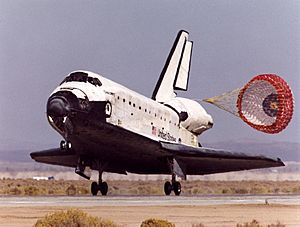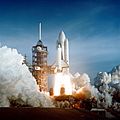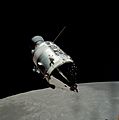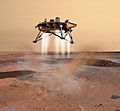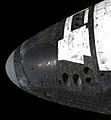Spacecraft facts for kids
A spacecraft is a vehicle that can carry people and cargo beyond the Earth's atmosphere, through space to other planetary bodies, space stations, or orbits and back home again. Spacecraft which are launched from the surface of a planet are called launch vehicles and usually take-off from launch pads at spaceports.
Most spacecraft today are propelled by rocket engines, which shoot hot gases opposite to the direction of travel. Other forms of propulsion are used when appropriate. Spacecraft which do not need to escape from strong gravity may use ion thrusters or other more efficient methods.
Because of the very large amount of energy needed to leave the Earth's gravity, spacecraft are usually very expensive to build, launch, and operate. Plans for future spacecraft often focus on reducing these costs so more people can participate in space. But today, costs are still very high, and until recently all spacecraft were sponsored by national governments.
Human spaceflight vehicles
Most expensive of all is to send people in to space, due to their needs for food, water, air, living space, safety, and control. People participating in this way have special names: Americans call themselves astronauts; Russians call themselves cosmonauts; Chinese call themselves taikonauts.
- The American agency NASA used a launch vehicle called the Space Shuttle. Currently, they go on Soyuz with the cosmonauts.
- The Russian agency RFSA uses a launch vehicle called Soyuz.
- The Ukrainian agency UASA uses a launch vehicle called Zenit.
- The Chinese agency CNSA uses a launch vehicle called Shenzhou.
- A private firm Virgin Galactic is building a launch vehicle called SpaceShipTwo.
Satellites
Some of the most important spacecraft today are artificial satellites. Artificial satellites are smaller, unmanned spacecraft. Some go into Low Earth orbit to look at the Earth or for other purposes. Others are sent to geostationary orbit to relay radio signals from one part of Earth to another, or to watch events on Earth from a high point of view. Communications satellites are important for television and other communications, and other satellites help with weather prediction and other jobs.
Related pages
Images for kids
-
The US Space Shuttle flew 135 times from 1981 to 2011, supporting Spacelab, Mir, the Hubble Space Telescope, and the ISS. (Columbia's maiden launch, which had a white external tank, shown)
-
More than 100 Soviet and Russian crewed Soyuz spacecraft (TMA version shown) have flown since 1967 and now support the International Space Station.
-
The first artificial satellite, Sputnik 1, launched by the Soviet Union
-
Jules Verne Automated Transfer Vehicle (ATV) approaches the International Space Station on Monday, March 31, 2008
-
Mariner 10 diagram of trajectory past planet Venus
-
Artist's conception of the Phoenix spacecraft as it lands on Mars
-
Artist's conception of Cassini–Huygens as it enters Saturn's orbit
-
Reaction control system thrusters on the front of the U.S. Space Shuttle
See also
 In Spanish: Nave espacial para niños
In Spanish: Nave espacial para niños


